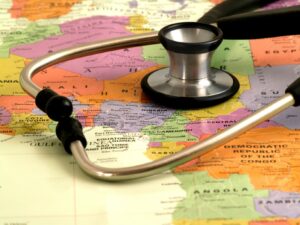EBOLA EPIDEMIC – A Global Health Emergency Democratic Republic of Congo
It is three years since the end of the last Ebola Epidemic in West Africa which killed over 11,000 people. In 2019 a growing number of Ebola cases have been reported in the Democratic Republic of Congo (DRC) and yesterday the WHO Director-General Dr. Tedros Adhanom Ghebreyesus declared the Ebola virus disease (EVD) outbreak in the DRC a Public Health Emergency of International Concern (PHEIC).
We have put together a fact sheet for those travelling or operating in affected or bordering countries
Location: Central Africa
Population: 81.5 million

Area: 2.34 million square km
Borders: Angola, Republic of Congo, Zambia, Tanzania, Burundi, Rwanda, Uganda, South Sudan, Central African Republic
Political stability: Recent history of civil war and corruption with ongoing safety and security threats
Healthcare: Due to political and economic collapse over the last 3 decades the hospitals have significant staff shortages and often run out of medicine and supplies
Chronic conditions: Malaria remains hugely prevalent, as well as TB, HIV and AIDS
Port town: Banana – small seaport in Kongo Central province which includes a Naval base
Port hospital: In the nearby town of Muanda – no data available, likely poor facilities
Evacuate point: Nairobi (Kenya) would have the nearest and best internationally standardised hospital, followed by Pretoria or Johannesburg (SA). Evacuating a patient with suspected or confirmed Ebola would require multi – agency negotiations and planning
EBOLA VIRUS DISEASE – EVD (formerly known as Ebola Haemhorragic Fever)
Transmission: Wild animals to humans and then human – to – human, with the fruit bat being the natural virus host. In humans it is spread via direct contact (through broken skin or mucous membranes) with blood or bodily fluids from an infected person or an object contaminated with blood or bodily fluids from an infected person
Fatality: Average is 50% with rates varying from 25% – 90%
Incubation: 2 – 21 days before symptoms appear. A person is infective once symptoms have appeared
Symptoms: Can be sudden and early symptoms may include; fever, fatigue, pain, headache and sore throat. These are then followed by vomiting and diarrhoea, rash, symptoms associated with liver and kidney impairment, internal and external bleeding (gums or stools)
Diagnosis: Body fluid and blood cultures as well as liver, platelet and clotting blood tests
Treatment: Early supportive treatment (rehydration) and specific symptom treatment improves survival. There is no proven treatment, however potential treatments are currently being evaluated
Prevention: The best prevention is to avoid all travel to areas affected by the Ebola epidemic. However if it is necessary to operate in these areas or bordering locations considered vulnerable then the following precautions should be taken
While in an area affected by Ebola, it is important to avoid the following:
- Contact with blood and body fluids (such as urine, faeces, saliva, sweat, vomit, breast milk, semen, and vaginal fluids).
- Items that may have come in contact with an infected person’s blood or body fluids (such as clothes, bedding, needles, and medical equipment).
- Funeral or burial rituals that require handling the body of someone who died from EVD.
- Contact with bats and nonhuman primates or blood, fluids and raw meat prepared from these animals (bushmeat) or meat from an unknown source.
- Contact with semen from a man who had EVD until you know the virus is gone from the semen.
Control: The use of personal protective equipment (PPE) and good hand hygiene in areas with confirmed or suspected EVD is required, with individuals being isolated in a single room with a private toilet. Hospitals, local Infectious Diseases Officials and Port Health Authorities should be notified immediately
Contact history: It would be a requirement to work with local and international health bodies to investigate the potential points of contact in order to take proactive steps to prevent and control further spread
References
The British Medical Journal: https://bestpractice.bmj.com/topics/en-gb/1210/diagnosis-approach
World Health Organisation: https://www.who.int/news-room/fact-sheets/detail/ebola-virus-disease



